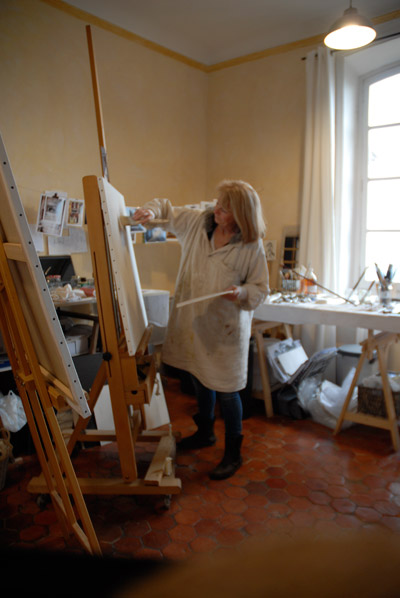Ceci est la traduction anglaise du billet « Comment commencer une peinture à l’huile ».
My name is Doro.T, I’m a painter living in Gordes in Luberon – Provence

Here are my suggestions. They are born out of personal experiences, also practical and used by many painters, many of whom won’t disclose their secrets.
I invite you to look at my paintings and read the information on my other pages. You will discover important information on oil and acrylic painting.
If you wish to leave comments or have questions, leave your email address (wich will remain confidential) and I will answer your questions.
Several solutions for you to chose from :
A – On prepared white canvas :
1) Draw a sketch :
Use graphite or charcoal (which I don’t suggest as it is dirty and leaves dust particles. It is not good if you prefer neat and clean work. Brush off excess with a cloth.
Or, use sanguine (which I often use), brush off excess particles with a cloth. When you paint on top of sanguine you might see some red, this isn’t a problem as it will be covered in the next layer.
Or, paint sketch directly with oil paint diluted with turpentine or odorless mineral spirit.
Or, no sketch at all to start with.
2) Preparing the « jus » for the under painting :
Jus is part oil paint and part odorless mineral spirit. It will look like watercolor. Often Ochre is used for the under painting. Paint the whole canvas with this mixture using a white bristle brush. Wipe off excess paint with a cloth if it’s too runny. You must still see your drawing underneath, if not touch up your sketch.
Prepare the next layer of paint, adding very little oil or medium.
B – On a prepared white canvas :
1) Draw a sketch as before, your choice of method.
2) With diluted mixtures, paint in the different colors, covering the canvas lightly. These are not your definite colors. If you continue at a later time, using a dark red (carmine, for example) it should be mixed with a diluted magenta. If you are using orange, it should be mixed with vermillion or cad, yellow deep.
You need to see a balanced mix of colors on your canvas. When the whole canvas is covered with colors, place your canvas facing a mirror. (Always have a mirror in your studio or work room). You’ll see if the colors are well placed and harmonious and if your sketch is good. Correct if necessary.
OUTLINE
These are the essential first steps.
First, preparing the canvas with the first layer of paint, then preparing the colors of your subject. And adding them.
Personally, I think too many artists are imagining themselves painting with inspiration but haven’t got the technique, so they’re painting without knowing how.
The base has been given for oil painting. You can also do the preparation in acrylics. You proceed in the same manner as before, except using acrylic paint thinned with water, using method A or B. When dry, you can continue with oil paint.
It is possible to paint oil paint over acrylics. NEVER paint acrylics over oil paint. It will be a catastrophic. Never forget the rule, FAT OVER LEAN !
It is for that reason glazing is the final stage, it has more oil or medium than the previous layers. Read about glazing in my blog.
BRUSHES
To start a painting it is advised to use a white bristle brush. The air is hard and white. The Filebert form is very practical. As you advance in your painting use a sable brush, they are softer. And more supple, leaving no brush strokes. Or, stay with the bristle brushes leaving brush strokes visible. It depends on your preference.
PALET KNIFE TECHNIQUE
This could be used after the initial under painting has ben done. Personally, I recommend to start with the palet knife immediately.
PLEIN AIR PAINTING
Painting outdoors, in the elements, rain, wing or sun is a choice. But, saying a painting was done under perfect conditions is another…
I’m not against preparing your canvas outside, but it’s best to finish it in your studio or work room.
Painting outside has it’s downfalls, dust, tiny insects, paint drying too fast, etc.. Canvases also need a certain amount of humidity.
Don’t hesitate to ask questions and give comments.
Doro.T
Bonjour. J ai beaucoup aimé votre tuto sur les glacis et les conseils du matériel. je débute, pouvez vous me dire si l on peut utiliser 2 marques differentes par ex : Rembrant et old holland sur une même toile ?
C est sans doute déconseillé dans le frais.
Merci d avance !
Bonjour, pour répondre à votre question, oui il est possible d’utiliser des marques différentes sur une même toile. A condition qu’elles soient de même « qualité », c’est à dire, des extra-fines. Pour Old Holland pas de problème, elles le sont. Pour les Rembrandt bien regarder sur vos tubes, qu’elles sont extra-fines. Vous remarquerez par ailleurs, que pour les O.H., il faut peu de matière car elles sont fortement pigmentées. Bonne journée ! D.